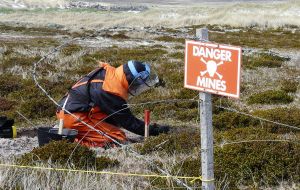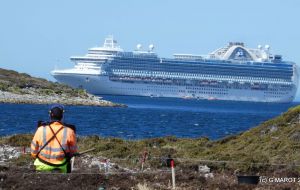MercoPress. South Atlantic News Agency
From Dreams to Reality: The Falklands now cleared of Argentine Mines
 Guy Marot of Fenix Insight and John Hare of SafeLane Global holding the last mine removed from the ground and which will be detonated this Saturday in a special celebration (Pics G. Marot)
Guy Marot of Fenix Insight and John Hare of SafeLane Global holding the last mine removed from the ground and which will be detonated this Saturday in a special celebration (Pics G. Marot)  The “Zims” displaying their expertise working in a mined field behind the fences that kept Falkland Islanders off grounds for 38 years
The “Zims” displaying their expertise working in a mined field behind the fences that kept Falkland Islanders off grounds for 38 years  A beautiful sight, clearing a field of mines close to a beach and in the background one of the many cruise vessels that call in the Falklands in summer season
A beautiful sight, clearing a field of mines close to a beach and in the background one of the many cruise vessels that call in the Falklands in summer season  A patch of land that has been cleared of mines by a prodder. However land was later restituted to its environment original
A patch of land that has been cleared of mines by a prodder. However land was later restituted to its environment original  Shupikayi Chipunza, 'Shupi' arrived in 2009 with the initial group of deminers and now lives in the Islands with his family with a Permanent Residency Permit
Shupikayi Chipunza, 'Shupi' arrived in 2009 with the initial group of deminers and now lives in the Islands with his family with a Permanent Residency Permit STANLEY, Falkland Islands – On 14 June 1982 as British Forces liberated the beleaguered small Falkland Islands population from Argentine occupation and the Islanders rejoiced as British democracy was restored, disturbing rumours began to circulate – Argentine soldiers had reportedly been observed laying vast numbers of mines in areas close to the town and beyond.
The suspicions were soon substantiated as various victorious British Regiments entering the town reported that many of their Servicemen had stepped on mines and had suffered the consequences. It seemed inconceivable that in addition to their 74 days of incarceration the Islanders would also now be faced with a dangerous and damaging legacy which could and would bring massive disruption to their daily lives, in the years ahead.
Contrary to reports at the time which circulated world-wide, the Argentine Engineers did make diagrams and maps of the areas where they had laid the mines and their Chief Engineer officially handed over the documents to Major Roddy McDonald the Officer Commanding 59 Cdo Squadron RE.
Word soon filtered through that mines had also been laid at Darwin/Goose Green, a large sheep farm of 300,000 acres and with a population of 100,000 sheep, and also on West Falklands at Port Howard and Fox Bay East & West.
The statistics were alarming in the extreme as the Argentine Government eventually revealed that around 20,000 anti-personnel mines and 5,000 anti-vehicle (tank) mines had been laid in up to 151 individual minefields or Booby Trap area mine-fields. Worse still many of the popular sand beaches close to the town had been subjected to mine laying and there seemed no prospects whatsoever of these virtually undetectable ‘plastic’ mines ever being located in the future. Very quickly the British Royal Engineers pinpointed Rookery Bay, Yorke Bay, and Lake Point as being ‘no-go’ areas.
Sunday school picnics, organized by the Churches, and a regularly feature of the daily lives of school children had to be abandoned, as were Christmas Day barbeques and annual sand-castle competitions.
According to Guy Marot, a former Royal Engineer Major who served in the Falklands as Officer Commanding the Joint Service's Explosive Ordnance Disposal Detachment (known locally as the EOD) in 1988, the mines had been laid by the Argentine Engineers ‘in an extremely disciplined manner and there was no evidence, as was previously suggested, that there was any indiscriminate laying’. He added that: ‘The Argentines were fully compliant with the 1980 revised Geneva Convention which related to mine laying, and all documentation was duly handed over officially in the appropriate manner.’
It soon became apparent that it would also be necessary to educate children with respect to what a mine or any other munitions looked like and what action they should take if they inadvertently came across one. Royal Engineer conducted weekly ‘lessons’ in school and very quickly most Falklands children could easily identify a Spanish P4B – Italian SB33 – Israeli No.4 and an Argentine FMK1 – all of which are anti-personnel mines designed to take off a foot or lower leg.
Initially the British Royal Engineers took on the task of clearing the mines but disaster struck early on as three soldiers lost limbs and then in January 1983 Major Steve Hambrook stepped on a mine at Fox Bay West - losing his lower leg, and this was shortly followed by a similar incident on the Stanley Common when Major Geoff Ward also lost a limb after stepping on an anti-personnel mine in August 1983. However Guy Marot, who has spent the past 11 years in the Islands as Programme Manager for FENIX INSIGHT, a Company appointed by the British Foreign, Commonwealth and Development Office to manage the quality, safety and environmental aspects of the mine clearance work by SAFELANE GLOBAL, refused to blame the Argentines for the Ward and Hambrook incidents. He insisted that ‘safety fences erected by Royal Engineers, soon after the Conflict, had been hastily and unfortunately wrongly situated’.
Following these unfortunate incidents the British Government ordered an immediate cessation of all active minefield clearance work, although for the next 26 years a small EOD Detachment diligently maintained the fences, maintained a surveillance of all minefields and using a remotely controlled piece of equipment did locate and destroy many mines which could be seen visually and were considered to be a danger to the public.
Britain as a signatory to the Ottawa Convention on the Prohibition and use of Anti-personnel mines was obliged to finance a major minefield clearance operation in the Falklands and the work should have commenced as far back as 1998, but consistent disputes with Argentina as to whose responsibility it was to finance and lift the mines, delayed the operation until 2009. A company named BACTEC (later to change its name to SAFELANE GLOBAL) won the British Government contract with FENIX INSIGHT appointed as the supervisory body. John Hare, a former Royal Engineer Warrant Officer who was injured in a ‘blue on blue’ (friendly fire) incident on Port Sussex mountain in the Falklands in 1982'returned to the Islands with a team of Zimbabweans, most of whom had previously been employed by BACTEC in Lebanon and other problem areas where mines had been laid.
Asked what were the most challenging aspects of the mine clearance programme Guy Marot pin-pointed the Falklands notorious and changing weather. ‘In some minefields the ‘Zims’ were knee deep in peat and water but they are phenomenal men in terms of their strength and ability and stuck to the task whatever the conditions’. As to the actual complexity of the minefields themselves he spoke of Wall Mountain, some 10 miles west of Stanley, which contained 1,295 Spanish P4B mines over a distance of 1.7 kilometers.
Only 2 minor incidents were recorded during the 11 years of de-mining. In 2009 a Zimbabwean prematurely set off a mine while using a ‘prodder’. He escaped injury totally. In 2013 another man sustained a cut on the back of his hand which required 6 stitches after he too hit the edge of a mine with his excavating trowel.
While the lifting of the final Argentine mine will be celebrated in the Falklands on Saturday with speeches by the Deputy Governor Mr. Alex Mitham, an elected Member of the Legislative Assembly Leona Roberts and Guy Marot, the demining process has brought some unexpected immigrants as no less than 19 of the Zimbabwean deminers have decided to remain in the Falklands and have all managed to obtain employment in a variety of professions.
42 year old Shupikayi Chipunza who arrived in 2009 with the initial group of deminers saw the potential for a better standard of living. ‘All of our accommodation and food was provided free of charge and we earned £450 a month with BACTEC when I first came to work in the Islands, while back in Zimbabwe I would be fortunate to earn $400, so I was able to send £200 a month to my family in Zimbabwe and save most of the rest of the money. The Zimbabweans more recently were paid in the region of £1,000 plus a month. After 2 years Shupi, as he is generally known, applied for and obtained, a Permanent Residency Permit and in 2013 he brought his wife and 3 children to the Islands, and was initially employed as a carpet layer before becoming a Fire Fighter with the local Government Air Service. He also proved to be an excellent football player and was chosen to represent the Islands at several International competitions in Europe and Bermuda.
Shupi said: ‘It was a good move for me and I have no regrets at all as we have been accepted into the community and never encountered any problems. I bought a piece of land and built my own house, and now my 16 year old daughter Mavis is being educated at Chichester college in England and all her education and boarding fees and air fares between the Falklands and U.K. are paid for by the Falklands Government’
Other Zimbabwean deminers followed his example and have settled permanently in the Islands while bringing their families with them and there are now in excess of 50 Zimbabwean nationals domiciled in the Islands and fully employed.
The total cost of the clearing the mines amounted to £44 million but the Falklands Government was not required to contribute one penny towards the project. The agreement between the U.K. and Falklands is that although the Islands are self-governing the Foreign & Defense Policy is provided by the U.K. Government. Demining is a treaty obligation and therefore the cost falls to the Foreign, Commonwealth and Development Office.
38 year ago it seemed totally impossible to believe that the Islands population would ever again be allowed access to traditional locations such as the Stone Corral, Eagle Rock, Eliza Cove, Lake Point and particularly the beautiful and alluring sand beach at Yorke Bay. But now, thanks to the commitment and diligence of the Zimbabwean deminers and the financial backing of the British Government, the dream has become a reality.
By Special Correspondent - Stanley




Top Comments
Disclaimer & comment rules-

-

-

Read all commentsGood all the mines are now gone !!
Nov 14th, 2020 - 09:55 am +5Great job guys, shame Argentina!!!
Nov 14th, 2020 - 10:17 am +4What lies Argie?
Nov 14th, 2020 - 12:29 pm 0Commenting for this story is now closed.
If you have a Facebook account, become a fan and comment on our Facebook Page!